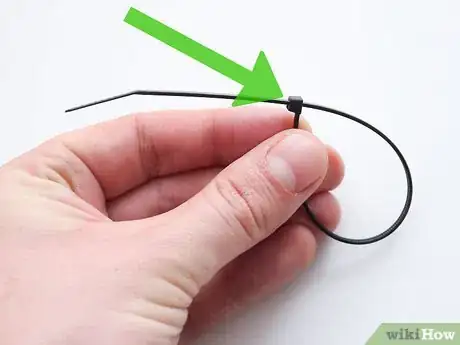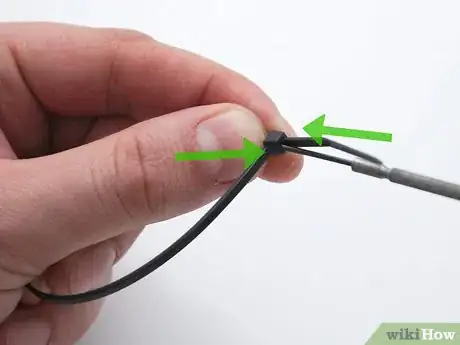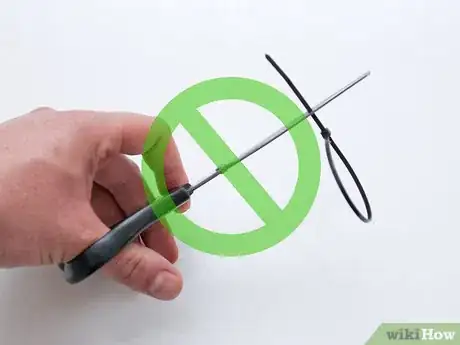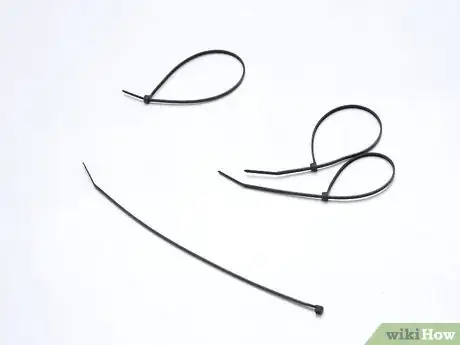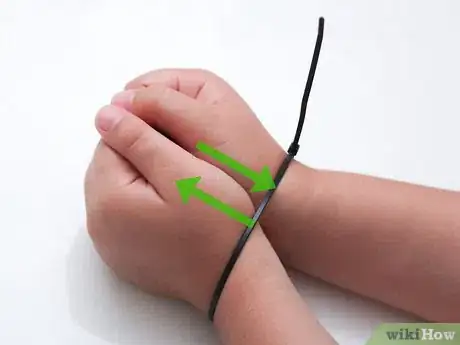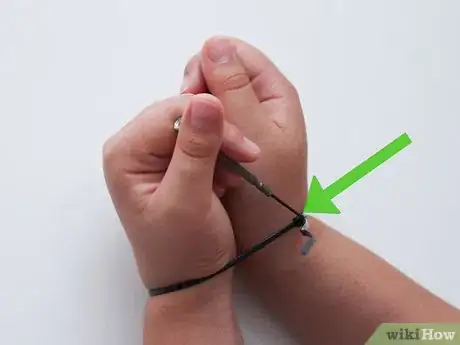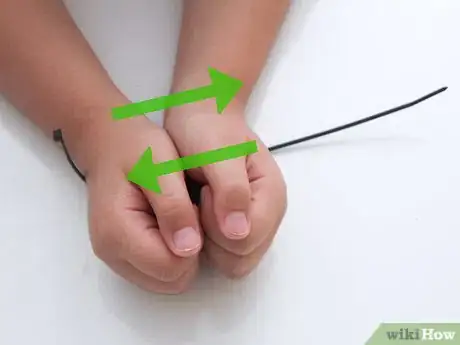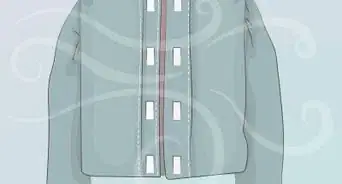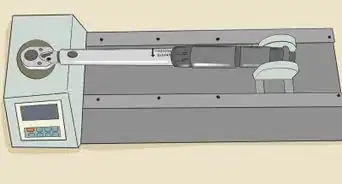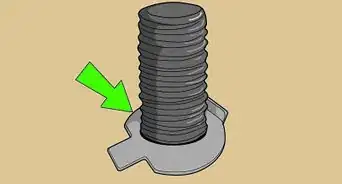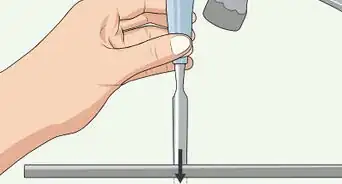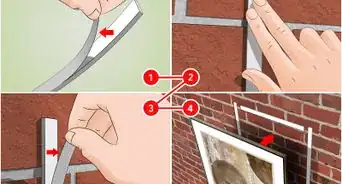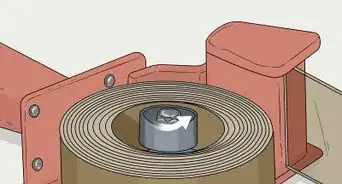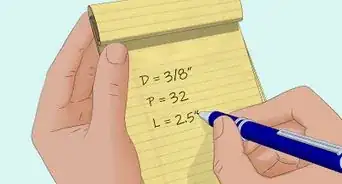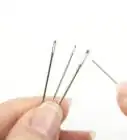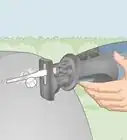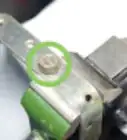This article was co-authored by wikiHow Staff. Our trained team of editors and researchers validate articles for accuracy and comprehensiveness. wikiHow's Content Management Team carefully monitors the work from our editorial staff to ensure that each article is backed by trusted research and meets our high quality standards.
This article has been viewed 364,388 times.
Learn more...
Cable ties typically come in two types: single-use and reusable. However, you can easily undo a single-use tie without having to cut it open so you can reuse it again. But since it’s only meant for a one-time use, there a couple of pointers to remember when reusing them. On a scarier note, cable ties are also often used as restraints during home invasions, but thankfully it’s possible to escape them even with your hands tied.
Steps
Unlocking the Tie
-
1Find the locking mechanism. If you look at a ready-to-use cable tie, notice that one end tapers to a point, while the other is capped with a tiny cube. When used, the pointy end is fed through a slot in the cube to form a loop and then pulled tight. The cube is the locking mechanism that keeps the tie from worming back out through the slot, so look for that.[1]
-
2Bend the tie’s loose end back. Notice how the loose end tends to curve over the locking mechanism once it’s fed through it. You want access to that side of the cube, so bend the tie back to expose it some more.[2]Advertisement
-
3Depress the bar. Look underneath the loose end where it comes out of the cube. Use your fingernail or any tool you may need (like a nail or pocket-size screwdriver) to push down on the bar that you find there. This releases the locking mechanism.[3]
-
4Pull the loose end back through the cube. Keep pushing down on the bar. As you do, use your other hand to slowly draw the loose end back through the cube. Once it’s out, you’re all done![4]
Reusing Ties
-
1Refrain from trimming them. If you want to use the same tie over and over again for different things, don’t cut the loose end off once it’s in use. All that excess may be unsightly, but remember: once you snip it off, you’ll only be able to use that tie for bundles of the same size or smaller.[5]
-
2Anticipate wear and tear. Keep in mind that single-use zip-ties are designed for just that. Even though you can technically undo them and use them again, expect the plastic teeth to possibly wear down the more you undo and retie them. Also keep in mind that manipulating the locking mechanism can damage it. The tie may develop a looser grip over time, so avoid using old ones to tie anything that really, really needs to be secured.[6]
-
3Use reusable cable ties instead. If you’re constantly using and reusing single-use ties for short-term projects, consider another option. Invest in some cable ties that are specifically designed for reuse. These cost a little more (and may not be ideal to use for one long-term project since they are much easier to open), but the money may be worth it if it saves you time.[7]
Freeing Yourself from Restraints
-
1Worm your hands out. First, be sure to squeeze your hands into fists with the tops of your hands facing up when your hands are being bound. This will make them as big as possible (and thus make your restraints larger, too). Then, when no one’s looking, relax your hands and turn your palms toward each other. Focus on worming your thumbs out first to make the rest easier.[8]
- Always try this method first, since another method will require you to tighten the cable tie (which will make trying to do this afterward much tougher).
-
2Spring the locking mechanism open. If you’re being held with other prisoners, coordinate between yourselves. Find a shim of some sort that’s small and firm enough to manipulate the bar inside the locking mechanism. Have one person use that to free the other by lifting the bar from the zip tie’s grooved tracks. Once it’s lifted, pull the tie free of the mechanism.[9]
- Possible shims could be a nail, screw, fork, pin, pen, pencil, key, or the corner of a credit card. If nothing’s in reach, try your fingernail.
- This is method works best with a partner, but you can also attempt it on your own.
-
3Snap the tie in two. For this, you want to hold the cable tie’s locking mechanism (which is where the tie is weakest) in between your hands. Use those and/or your teeth to get the mechanism into position and pinned between your hands or balls of your thumbs. Then grip the tie’s loose end between your teeth and pull to tighten it as much as possible. Next:[10]
- Raise your hands above your head and then swing them down in toward your stomach as fast as you can.
- As you swing them down, focus on touching your shoulder blades together and sticking your elbows out like wings.
- Repeat if needed until the locking mechanism snaps in between your hands.
-
4Finished.
References
- ↑ https://www.youtube.com/watch?v=GTubRYlY6U4
- ↑ https://www.youtube.com/watch?v=GTubRYlY6U4
- ↑ https://www.youtube.com/watch?v=GTubRYlY6U4
- ↑ https://www.youtube.com/watch?v=GTubRYlY6U4
- ↑ http://lifehacker.com/5903220/unhook-and-reuse-plastic-zip-ties-with-a-simple-trick
- ↑ http://lifehacker.com/5903220/unhook-and-reuse-plastic-zip-ties-with-a-simple-trick
- ↑ https://www.cableorganizer.com/cableties-wrap-clips/cable-ties.htm
- ↑ http://www.artofmanliness.com/2014/03/27/3-ways-to-escape-zip-ties-an-illustrated-guide/
- ↑ http://www.artofmanliness.com/2014/03/27/3-ways-to-escape-zip-ties-an-illustrated-guide/
About This Article
To open a cable tie, first, find the cube that houses the locking mechanism. Once you have your attention on the cube, bend back the loose end of the tie that has been fed through the locking mechanism. With the loose end pulled back, use a small nail or pocket-sized screwdriver to push down the bar inside of the cube, which should release the locking mechanism. While the bar is held down, slowly draw the loose end back through the cube with your other hand. For more help, including how to free yourself from cable tie restraints, scroll down.
